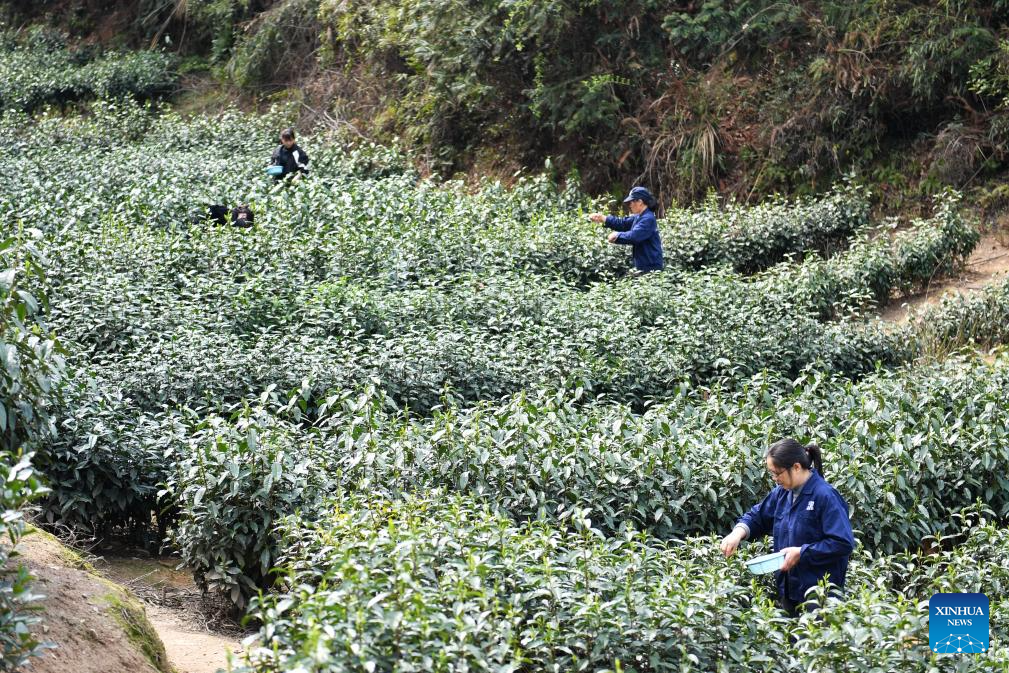
Farmers pick tea leaves at a tea garden in Malu Township of Anhua County, central China's Hunan Province, March 26, 2024. Recently, farmers are busy harvesting tea leaves in Anhua County, a main producing area of dark tea in China. The county has 360,000 mu (24,000 hectares) of tea gardens with nearly 400,000 local people engaged in tea related industries.
By 2023, there are more than 200 tea processing enterprises in Anhua and the comprehensive output value of the industry reached 25.2 billion yuan (about 3.49 billion US dollars) last year. (Xinhua/Chen Zhenhai)

A farmer picks tea leaves at a tea garden in Malu Township of Anhua County, central China's Hunan Province, March 26, 2024. Recently, farmers are busy harvesting tea leaves in Anhua County, a main producing area of dark tea in China. The county has 360,000 mu (24,000 hectares) of tea gardens with nearly 400,000 local people engaged in tea related industries.
By 2023, there are more than 200 tea processing enterprises in Anhua and the comprehensive output value of the industry reached 25.2 billion yuan (about 3.49 billion US dollars) last year. (Xinhua/Chen Zhenhai)

An aerial drone photo shows tea gardens in Malu Township in Anhua County, central China's Hunan Province, March 26, 2024. Recently, farmers are busy harvesting tea leaves in Anhua County, a main producing area of dark tea in China. The county has 360,000 mu (24,000 hectares) of tea gardens with nearly 400,000 local people engaged in tea related industries.
By 2023, there are more than 200 tea processing enterprises in Anhua and the comprehensive output value of the industry reached 25.2 billion yuan (about 3.49 billion US dollars) last year. (Xinhua/Chen Zhenhai)
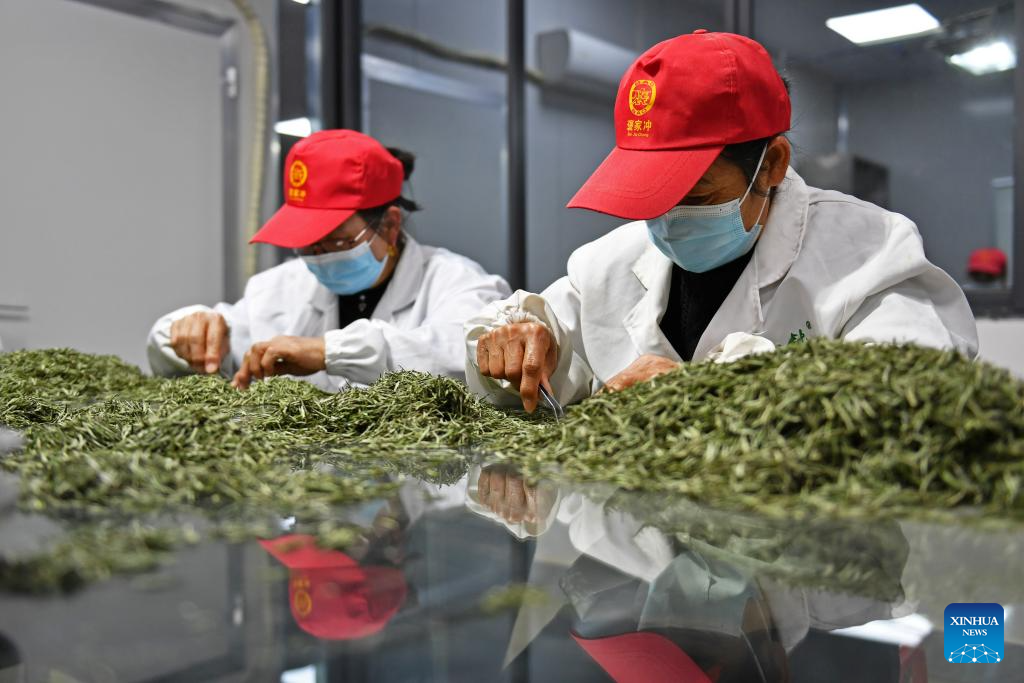
Workers select tea leaves at a tea processing enterprise in Dongping Township of Anhua County, central China's Hunan Province, March 26, 2024. Recently, farmers are busy harvesting tea leaves in Anhua County, a main producing area of dark tea in China. The county has 360,000 mu (24,000 hectares) of tea gardens with nearly 400,000 local people engaged in tea related industries.
By 2023, there are more than 200 tea processing enterprises in Anhua and the comprehensive output value of the industry reached 25.2 billion yuan (about 3.49 billion US dollars) last year. (Xinhua/Chen Zhenhai)
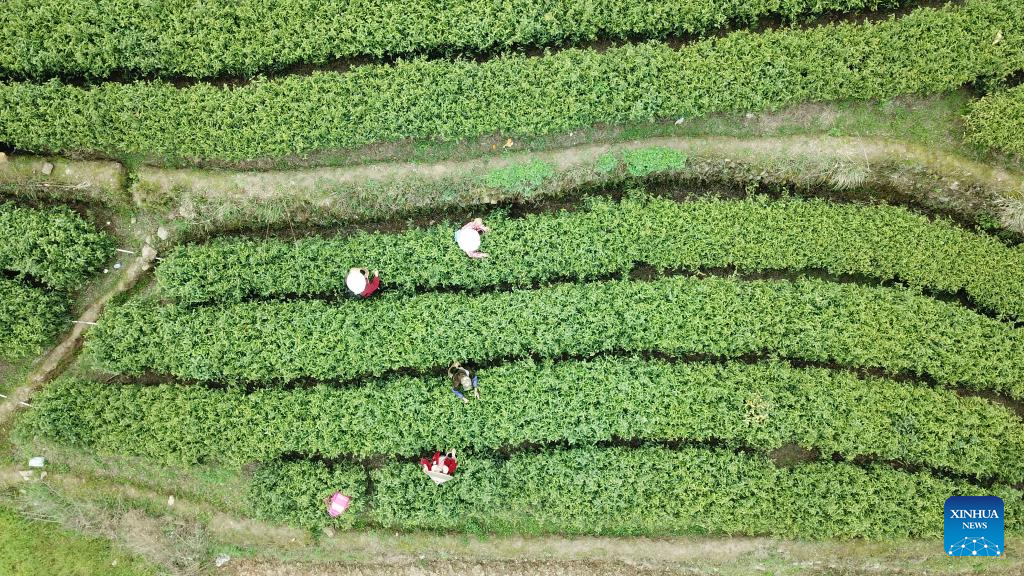
An aerial drone photo shows farmers working at a tea garden in Malu Township in Anhua County, central China's Hunan Province, March 26, 2024. Recently, farmers are busy harvesting tea leaves in Anhua County, a main producing area of dark tea in China. The county has 360,000 mu (24,000 hectares) of tea gardens with nearly 400,000 local people engaged in tea related industries.
By 2023, there are more than 200 tea processing enterprises in Anhua and the comprehensive output value of the industry reached 25.2 billion yuan (about 3.49 billion US dollars) last year. (Xinhua/Chen Zhenhai)
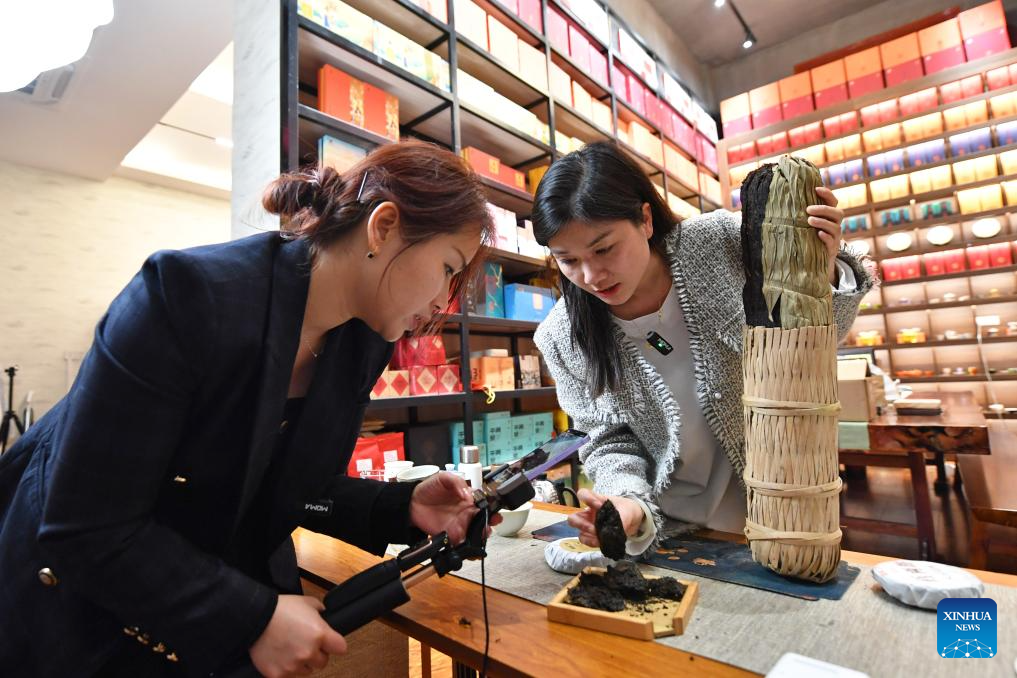
Saleswomen sell dark tea bricks via live-streaming in Anhua County, central China's Hunan Province, March 26, 2024. Recently, farmers are busy harvesting tea leaves in Anhua County, a main producing area of dark tea in China. The county has 360,000 mu (24,000 hectares) of tea gardens with nearly 400,000 local people engaged in tea related industries.
By 2023, there are more than 200 tea processing enterprises in Anhua and the comprehensive output value of the industry reached 25.2 billion yuan (about 3.49 billion US dollars) last year. (Xinhua/Chen Zhenhai)
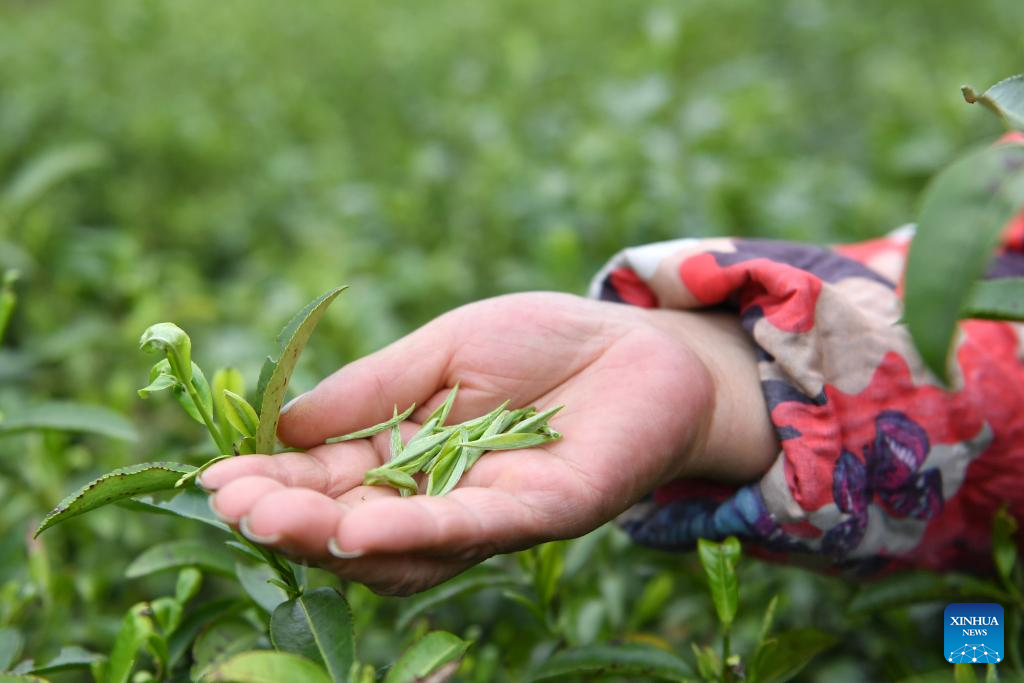
A farmer shows fresh tea leaves picked at a tea garden in Malu Township of Anhua County, central China's Hunan Province, March 26, 2024. Recently, farmers are busy harvesting tea leaves in Anhua County, a main producing area of dark tea in China. The county has 360,000 mu (24,000 hectares) of tea gardens with nearly 400,000 local people engaged in tea related industries.
By 2023, there are more than 200 tea processing enterprises in Anhua and the comprehensive output value of the industry reached 25.2 billion yuan (about 3.49 billion US dollars) last year. (Xinhua/Chen Zhenhai)

A drone photo shows a museum of Anhua dark tea in Anhua County, central China's Hunan Province, March 27, 2024. Recently, farmers are busy harvesting tea leaves in Anhua County, a main producing area of dark tea in China. The county has 360,000 mu (24,000 hectares) of tea gardens with nearly 400,000 local people engaged in tea related industries.
By 2023, there are more than 200 tea processing enterprises in Anhua and the comprehensive output value of the industry reached 25.2 billion yuan (about 3.49 billion US dollars) last year. (Xinhua/Chen Zhenhai)
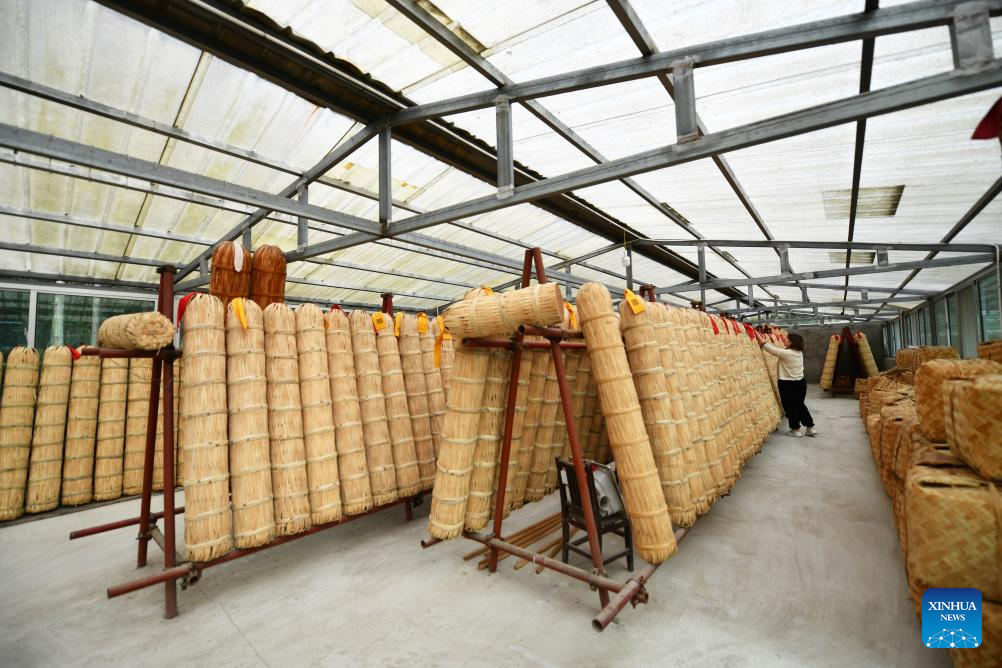
A worker checks on tea at a warehouse of a tea processing enterprise in Malu Township of Anhua County, central China's Hunan Province, March 26, 2024. Recently, farmers are busy harvesting tea leaves in Anhua County, a main producing area of dark tea in China. The county has 360,000 mu (24,000 hectares) of tea gardens with nearly 400,000 local people engaged in tea related industries.
By 2023, there are more than 200 tea processing enterprises in Anhua and the comprehensive output value of the industry reached 25.2 billion yuan (about 3.49 billion US dollars) last year. (Xinhua/Chen Zhenhai)
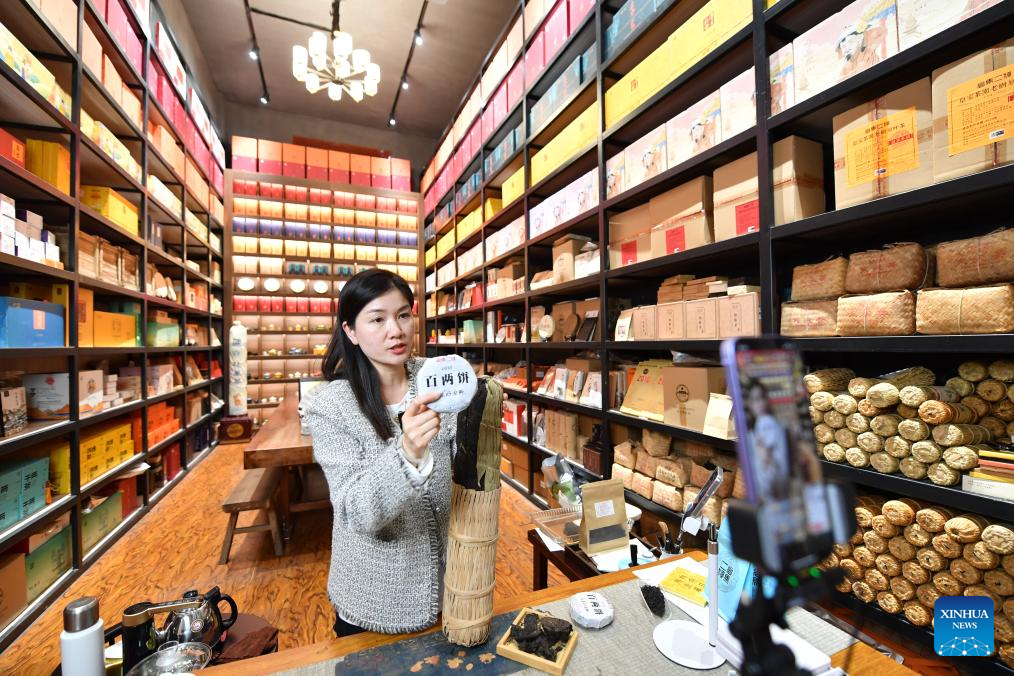
A saleswoman sells dark tea bricks via live-streaming in Jiangnan Town of Anhua County, central China's Hunan Province, March 26, 2024. Recently, farmers are busy harvesting tea leaves in Anhua County, a main producing area of dark tea in China. The county has 360,000 mu (24,000 hectares) of tea gardens with nearly 400,000 local people engaged in tea related industries.
By 2023, there are more than 200 tea processing enterprises in Anhua and the comprehensive output value of the industry reached 25.2 billion yuan (about 3.49 billion US dollars) last year. (Xinhua/Chen Zhenhai)

A worker checks on tea at a warehouse of a tea processing enterprise in Malu Township of Anhua County, central China's Hunan Province, March 26, 2024. Recently, farmers are busy harvesting tea leaves in Anhua County, a main producing area of dark tea in China. The county has 360,000 mu (24,000 hectares) of tea gardens with nearly 400,000 local people engaged in tea related industries.
By 2023, there are more than 200 tea processing enterprises in Anhua and the comprehensive output value of the industry reached 25.2 billion yuan (about 3.49 billion US dollars) last year. (Xinhua/Chen Zhenhai)
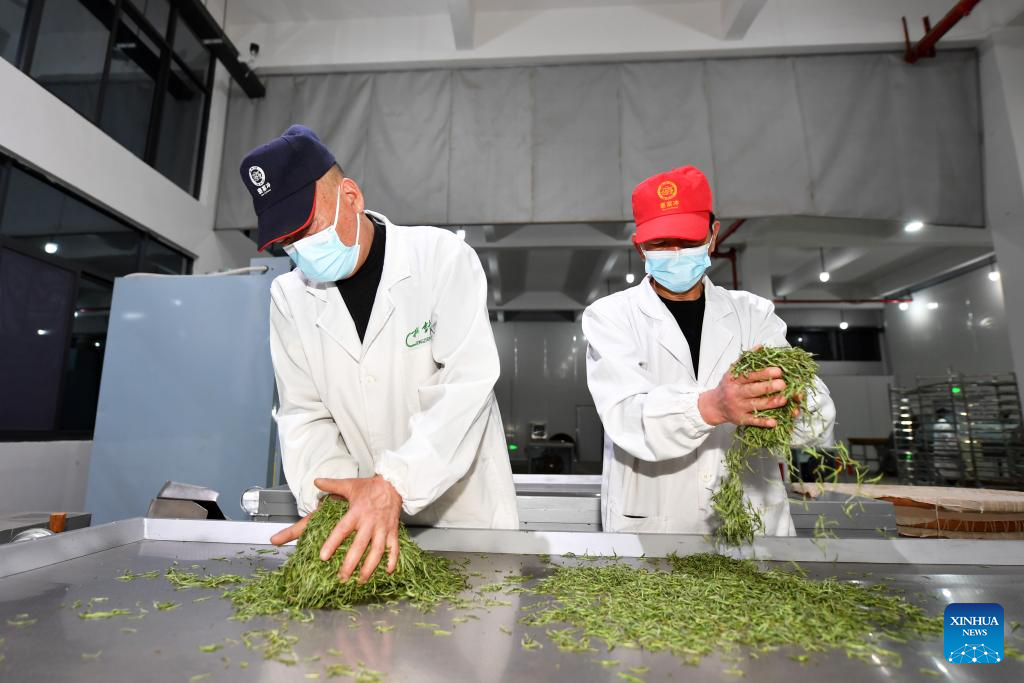
Workers process tea leaves at a tea processing enterprise in Dongping Township in Anhua County, central China's Hunan Province, March 26, 2024. Recently, farmers are busy harvesting tea leaves in Anhua County, a main producing area of dark tea in China. The county has 360,000 mu (24,000 hectares) of tea gardens with nearly 400,000 local people engaged in tea related industries.
By 2023, there are more than 200 tea processing enterprises in Anhua and the comprehensive output value of the industry reached 25.2 billion yuan (about 3.49 billion US dollars) last year. (Xinhua/Chen Zhenhai)

A man works at a tea processing enterprise in Dongping Township of Anhua County, central China's Hunan Province, March 26, 2024. Recently, farmers are busy harvesting tea leaves in Anhua County, a main producing area of dark tea in China. The county has 360,000 mu (24,000 hectares) of tea gardens with nearly 400,000 local people engaged in tea related industries.
By 2023, there are more than 200 tea processing enterprises in Anhua and the comprehensive output value of the industry reached 25.2 billion yuan (about 3.49 billion US dollars) last year. (Xinhua/Chen Zhenhai)



